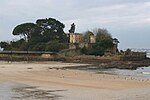Cambre is a municipality in the Province of A Coruña, in the autonomous community of Galicia in northwestern Spain. It is located 12 km from the capital city of A Coruña and ten minutes away from the city's airport, Alvedro.
According to the 2010 census, the municipality of Cambre includes 23,621 inhabitants spread over its 12 parishes, which occupy 41 square kilometres. The parishes are those of O Temple, Cambre, Sigrás, Anceis, San Lorenzo, Cela, Andeiro, Santa María de Vigo, Bribes, Brexo-Lema, Cecebre and Pravio. It shares municipal boundaries with the neighbouring municipalities of Culleredo, Carral and Oleiros.
The town of Cambre has many sites of interest. Among them are:
The Church of Our Lady Mary of Cambre (Spanish: Iglesia de Santa María de Cambre, Galician: Igrexa de Santa María de Cambre), built around the 12th century; an archaeological museum with a permanent exhibition of the remains of a Roman bathroom and latrine; and the house of Galician writer Wenceslao Fernández Flórez (1885–1964).
The town is located on the Way of St. James (Camino de Santiago), though on the English Way (Camino inglés), used mainly by pilgrims coming from England and Ireland via ship to A Coruña or Ferrol, and from there on foot to Santiago de Compostela.










